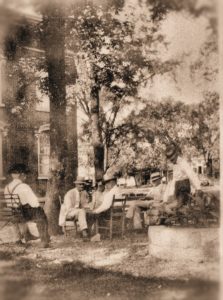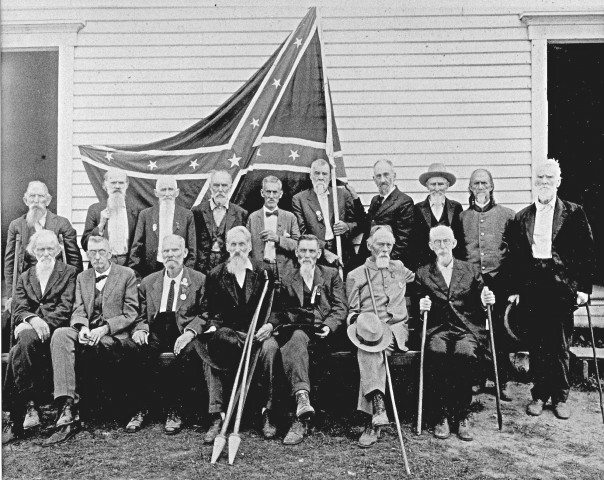Pictures of our Past
This picture was made in front of the Hillsboro Methodist Church at one of the last meetings of Manchester’s Frank Ragsdale Bivouac of Confederate Veterans, probably on 6 September 1924. Those pictured are: Seated left to right: Jim Neal, Gilbert Harrell, Jesse Cornelison, E. O. Morgan, Tom Bell, James F. Anthony and George W. Newman. 2nd Row standing left to right: Lewis Seahorn, Jim Henley, Bill Jenkins, Lot Ridner, Bob Willis, Bill Gentry, Polk Sims, Henry Darnell, F. M. “Tobe” Taylor and Pink Mash.
According to the records of W. T. Wilson, secretary, many years ago there was an active organization of ex-Confederate soldiers in Coffee County, the Frank Ragsdale Bivouac associated with the state and national Association of United Confederate Veterans … “an organization put on foot in 1890.” Their officers compiled a history of the soldiers who enlisted in “the late War between the States” giving their commands and the part which they took and whether living or dead and also all soldiers still living in Coffee county who enlisted elsewhere.
The roll of members, the Roll of Honor and the Constitution and Bylaws of the Association were recorded by the group and are on file at the Coffee County Historical Society along with numerous articles from the Manchester Times in 1889-1898 as well as information from the Tennessee State Library and Archives and other sources about this organization.
The Coffee County Historical Society has also published a 6-volume series on Civil War Soldiers of Coffee County, Tennessee, which contains photos and individual histories of those who served on both sides of the war, as well as interesting descriptions of the various aspects of the conflict. These are available for review or for sale at the Historical Society office, open Tuesday through Friday from 9:00 a.m. to 1:00 p.m. in the historic Courthouse on the square in Manchester. The Historical Society can be reached at 931-728-0145 or by email at cchs1969@att.net.
This is the grave of CSA General Benjamin Franklin Cheatham’s war horse Old Isham, named for Isham Harris, Confederate governor of Tennessee. Gen. Cheatham took the horse home with him to his farm after the war and when the horse died, he buried him with full military honors. In 2002, the Sons of Confederate Veterans located and marked the grave with a tombstone and dedicated the grave with speeches and a salute with rifles and cannon. Benjamin Franklin “Frank” Cheatham (October 20, 1820 – September 4, 1886) was a Tennessee planter and California gold miner. He served in the Army of Tennessee, inflicting many casualties on Sherman at Kennesaw Mountain.
Tullahoma was founded in 1852 as a work camp along the new Nashville and Chattanooga Railroad. The railroad was constructed in the 1850’s and by the 1860’s the railroad brought both the Confederate and the Federal armies to the county during the Civil War. Both armies occupied Tullahoma at different times during the Tullahoma Campaign. It has one of the longest railroad grades in the U.S. to Normandy and thence to Nashville. Note the water tower in the background and the stores on Northwest Atlantic Street on the right. There is snow which is rare in Tullahoma.
The State of Tennessee had granted the railroad what is known as a “charter right of way.” This meant that the landowners granted the railroad the right to build a track across their land without a deed or without the railroad actually buying it. The right of way was two hundred feet wide, one hundred feet on each side from the center line of the tracks. The date of this photo has to be between 1921 when the freight station was moved and 1941 when the depot was moved. The line through Tullahoma was the Nashville, Chattanooga, and St. Louis Railway since it wasn’t acquired by the L & N until 1957. It must be a steam engine since they weren’t converted to diesel until about 1953. There was a lot of excitement about the railroad. However, the only grade that could be used was the grade through the Normandy valley, otherwise known as the “Seven-mile Grade” to Tullahoma. This was and still is the only grade that can be used to the Cumberland Plateau.
 YARN SPINNING ON THE COURTHOUSE LAWN
YARN SPINNING ON THE COURTHOUSE LAWN
Many Coffee County residents still remember when it was popular for older gentlemen to sit and visit together on the courthouse lawn back in the days when there were numerous benches. They enjoyed swapping stories and often whittling small treasures out of wood. These were good times with good friends. A story is told about local dentist Dr. Myrtt Winton, who had an office on the second floor above Baker’s Drugstore. When he didn’t have a patient, Dr. Winton would often walk down to the courthouse and chat with the fellows gathered there. When a patient showed up, his nurse would hang a white towel out the window … her signal that it was time for Dr. Winton to get back to the office.



